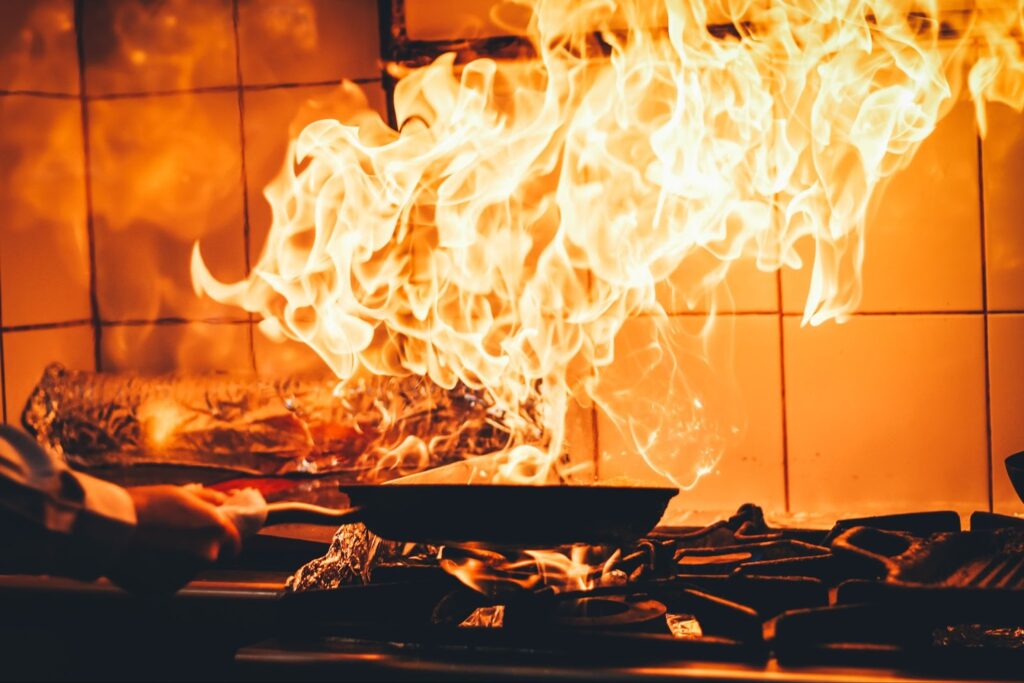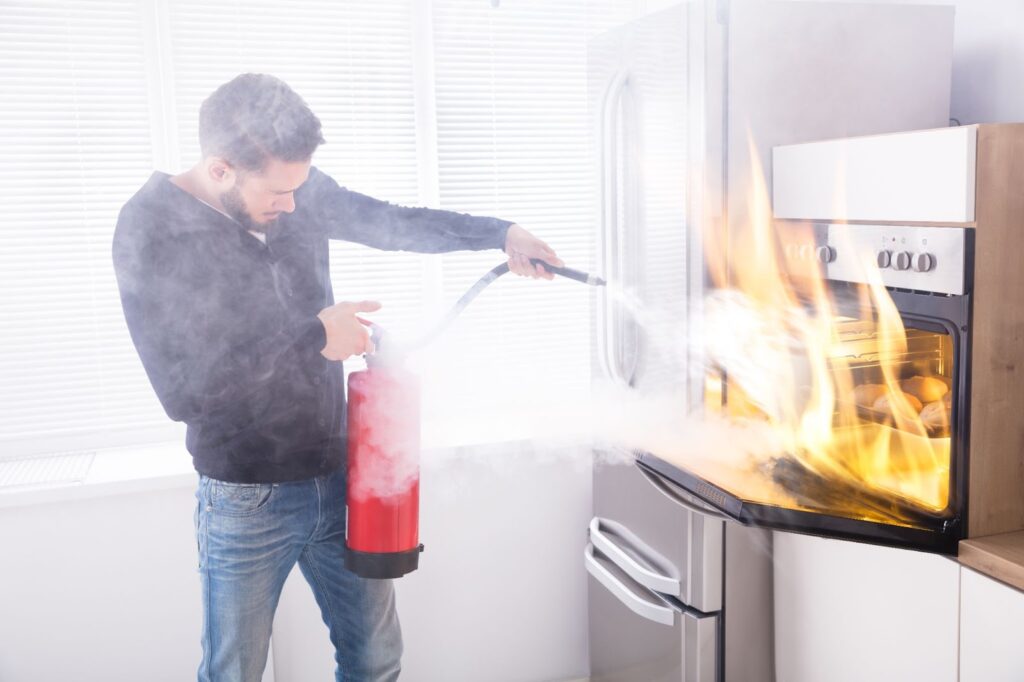A kitchen fire, often sparked by unattended cooking, grease buildups, or faulty appliances, presents significant challenges. The aftermath leaves homeowners grappling with the loss of their cooking space and potential structural and water damage.
This blog guides you through the necessary steps to restore your kitchen after a fire, emphasizing safety, efficiency, and functionality. With the right approach, you will transform the crisis of a kitchen fire into an opportunity to improve and modernize your cooking area, making it safer and more appealing than ever.
Initial steps post-fire
Immediately following a kitchen fire, prioritizing safety is essential. Before entering your kitchen, ensure it is structurally safe, checking for any signs of damage that might compromise the area’s integrity. Often, it’s best to wait for a professional’s approval to re-enter to avoid hazards like weakened structures or electrical risks.
Once the kitchen is deemed safe, your next step is to contact your insurance company. Start documenting the extent of the damage: take photos, list damaged items, and prepare a detailed account of the event for your insurance claim. This documentation is crucial for facilitating the claims process and securing the necessary repair funds.
Equally important is enlisting the services of professionals who specialize in assessing smoke, water, and fire damage. These experts thoroughly evaluate the impact, identifying not only obvious damage but also hidden issues such as structural weaknesses or potential mold growth areas.
Their insights will inform the restoration process, ensuring that all aspects of damage are appropriately addressed to restore your kitchen to a safe and appealing state.
Cleaning up
When tackling the clean-up after a kitchen fire, start by safely removing any debris. This includes charred items beyond repair and spoiled food, which pose health risks. Dispose of these items responsibly to prevent hazards and clear the space for further restoration.
Next, focus on eliminating soot and smoke residues, which embed themselves into surfaces, causing lingering odors and potential health risks. Employ specialized cleaning techniques and products designed for soot removal. These may include chemical sponges that don’t smear soot or specific cleaning solutions that break down the greasy residue left by smoke.
Water damage often accompanies the efforts to extinguish a kitchen fire, introducing another layer of challenge to the cleanup process. Promptly dry out the area using dehumidifiers and fans to accelerate the drying process. Ensure thorough drying to prevent mold growth, which begins within 24 to 48 hours in damp conditions.
For extensive water damage, consider engaging professional water damage restoration services to ensure that the area is dried efficiently and that any potential for future mold growth is addressed. This thorough approach helps in safeguarding the structure of your home and maintaining the health of its occupants.

Repairing structural damage
Repairing structural damage after a kitchen fire involves several critical steps to ensure your kitchen is safe and functional again.
Begin with a thorough inspection and repair of all electrical systems. Fire severely damages wiring and electrical fixtures, which poses significant risks. Licensed electricians should assess and repair any damages to prevent future hazards such as electrical shorts or further fires.
Next, address any affected plumbing and gas lines. Fires melt or dislodge piping, leading to leaks that could result in water damage or gas leaks. Have a professional plumber inspect and repair these systems to restore safe operation and ensure compliance with local building codes.
Finally, turn your attention to the structural integrity of walls, ceilings, and floors. Fire and water compromise these structures, necessitating comprehensive repairs. This might include patching or replacing sections of drywall, reinforcing support beams, and refinishing or replacing flooring materials.
In cases of severe damage, consider the expertise of a structural engineer to guide the repairs and ensure everything is rebuilt to safety standards.
Restoring or replacing cabinets and appliances
When tackling the restoration or replacement of cabinetry and appliances after a kitchen fire, it’s essential to carefully assess each item’s condition to make informed decisions.
Start with your cabinets: examine them for structural soundness and extent of damage. If the cabinets are mostly intact and the damage is superficial, such as light soot or smoke staining, professional cleaning, and refinishing might restore them to their former state.
However, if the fire has compromised the structural integrity or the materials are extensively charred, replacement will be necessary for safety and aesthetics.
Evaluate each appliance to determine if repair is feasible. Appliances exposed to high heat or water during firefighting efforts may have damaged internal components, making them unsafe or inefficient. Consult professionals to inspect these appliances; they will advise whether it’s more cost-effective to repair or replace them based on their current condition and potential repair costs.
If replacement becomes necessary, consider the opportunity to upgrade your kitchen. Choose appliances that offer improved energy efficiency, better performance, and enhanced features that fit your lifestyle. Look for models that comply with modern safety standards and offer better durability and reliability.
Whether restoring or replacing, the key is to ensure that all cabinetry and appliances look good and contribute to the overall functionality and safety of your kitchen.
Redesigning the kitchen
If you’re considering a redesign of your kitchen following fire damage, this might be the perfect opportunity to enhance both the layout and functionality of your space. Redesigning allows you to reevaluate your kitchen’s flow, optimize space usage, and incorporate modern conveniences that improve your daily life.
Start by thinking about the layout: does the current setup meet your needs, or could it benefit from more counter space, better movement flow, or perhaps an island? Reconfiguring the kitchen layout enhances its functionality and increases the enjoyment of your cooking and dining experience.
When selecting materials for your redesigned kitchen, prioritize fire-resistant options to enhance safety. Consider non-combustible materials such as fire-resistant glass for windows, backsplashes made of ceramic or glass tiles, and countertops of quartz or metal. Choose cabinetry treated with fire-retardant chemicals or made from materials less likely to catch fire.
Incorporating these elements increases the safety of your kitchen but also ensures that the design remains stylish and contemporary. Opt for a color scheme and design elements that reflect your personal style while also adding to your home’s overall resilience and value.
Preventative measures for the future
Installing smoke detectors in key locations throughout your kitchen and home provides early warnings that save lives and prevent property damage. Ensure these devices are always in working order by regularly checking and replacing batteries as needed.
Equally important is the installation of proper ventilation systems, such as range hoods over stoves, which help vent out smoke and reduce the buildup of flammable grease. Proper ventilation mitigates fire risks and improves air quality, making your kitchen a safer and more comfortable space for cooking and gathering.
Implementing safe kitchen practices is another vital step in fire prevention. Educate all household members about the dangers of leaving cooking unattended and the importance of keeping flammable materials — such as oven mitts, wooden utensils, and food packaging — away from the stove and oven. Regularly clean appliances and counters to remove grease buildup, which can fuel fires.

Kitchen cleanup and more from Utah Disaster Cleanup
If you’re facing the aftermath of a kitchen fire, Utah Disaster Cleanup is here to help. With expertise in smoke, water, and fire damage restoration, our team provides professional service that ensures your kitchen is restored to its former glory. It is also equipped with the best preventative measures against future incidents.
Trust Utah Disaster Cleanup to handle your restoration needs with care, efficiency, and the highest safety standards. Call 435-512-1584, and let us help you turn a moment of distress into a future of comfort and safety.



